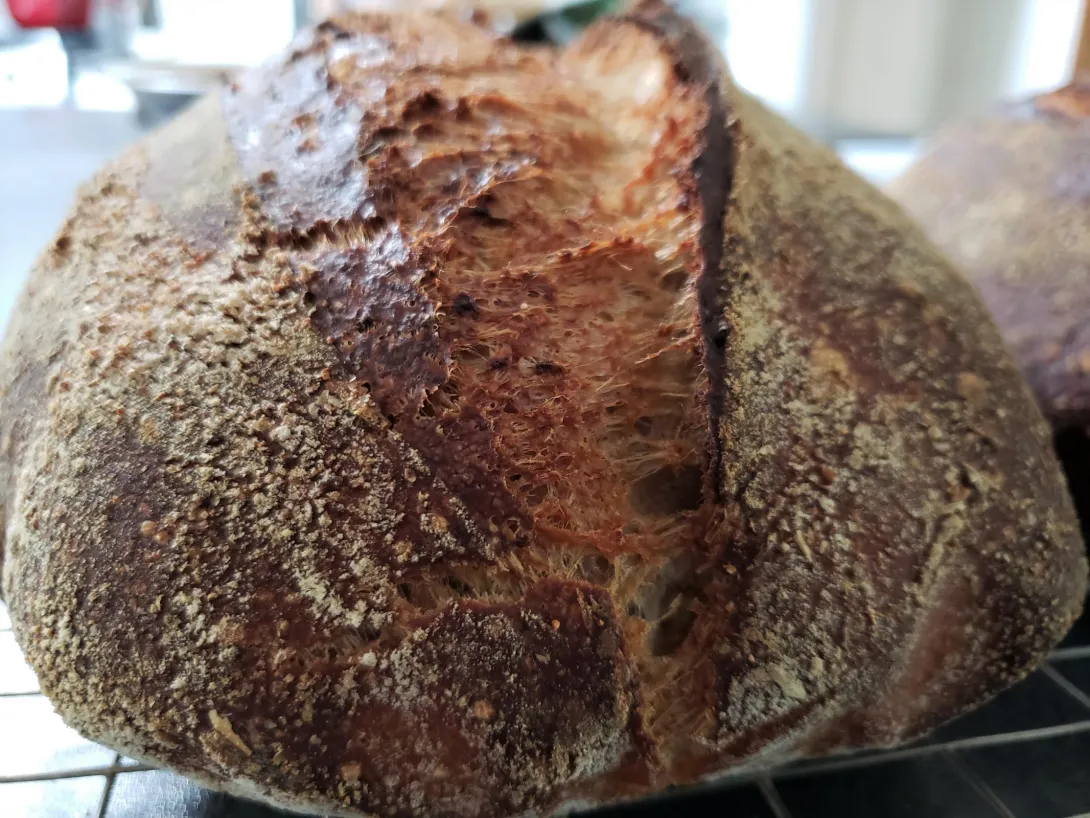
The basic ingredients for good bread - flour, salt, water, yeast - are simple yet can produce such a wonderful variety of breads with complex flavours, crumb textures, crusts. Sometimes in my tinkering and experimenting I need to remind myself that bread made just with these basic ingredients can be really good bread! So with that in mind, today's bake focused on the basics - good grain, salt, water and yeast.
Cracked Grain Porridge Sourdough Bread
- 250 g sifted mix of freshly ground organic rye, emmer and Marquis wheat (bran set aside for coating the loaves)
- 750 g organic all purpose flour
- 750 g filtered water (est.FDH 82% after addition of porridge)
- 22 g sea salt
- 225 g levain (4 hour)
- 300 g mixed cracked grains (rye, emmer, khorasan, Marquis, hulless oats, flax) cooked into a porridge
The cracked grain porridge was gently mixed into the dough after the second of four stretch/folds. After four hours the loaves were pre-shaped, rested for thirty minutes and then shaped and cold proofed overnight for 10 hours. I baked the loaves directly out of the fridge; covered for 25 minutes at 500 F; 10 minutes at 450 F and then uncovered, directly on the baking stone for 20 minutes at 450 F.
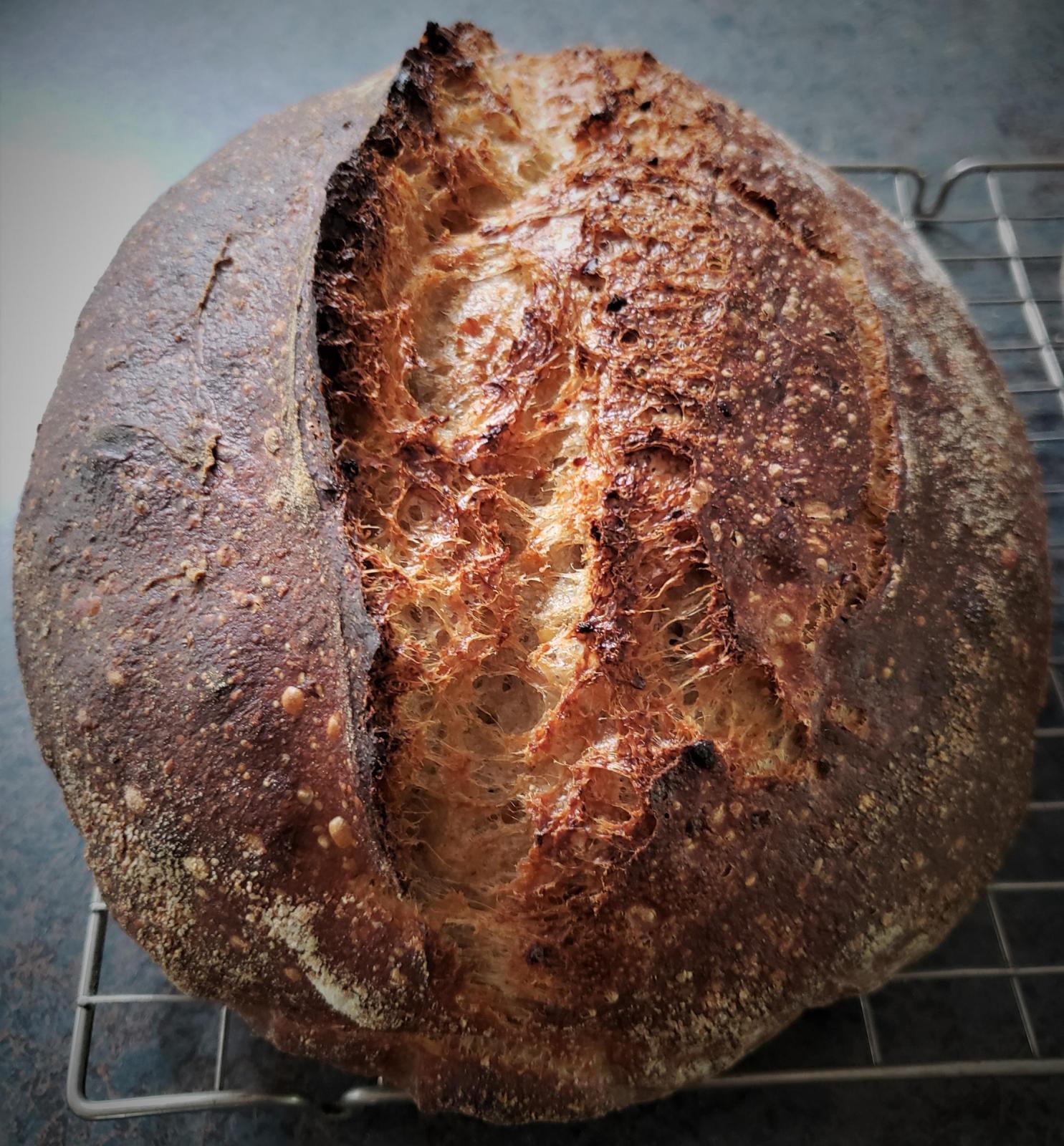
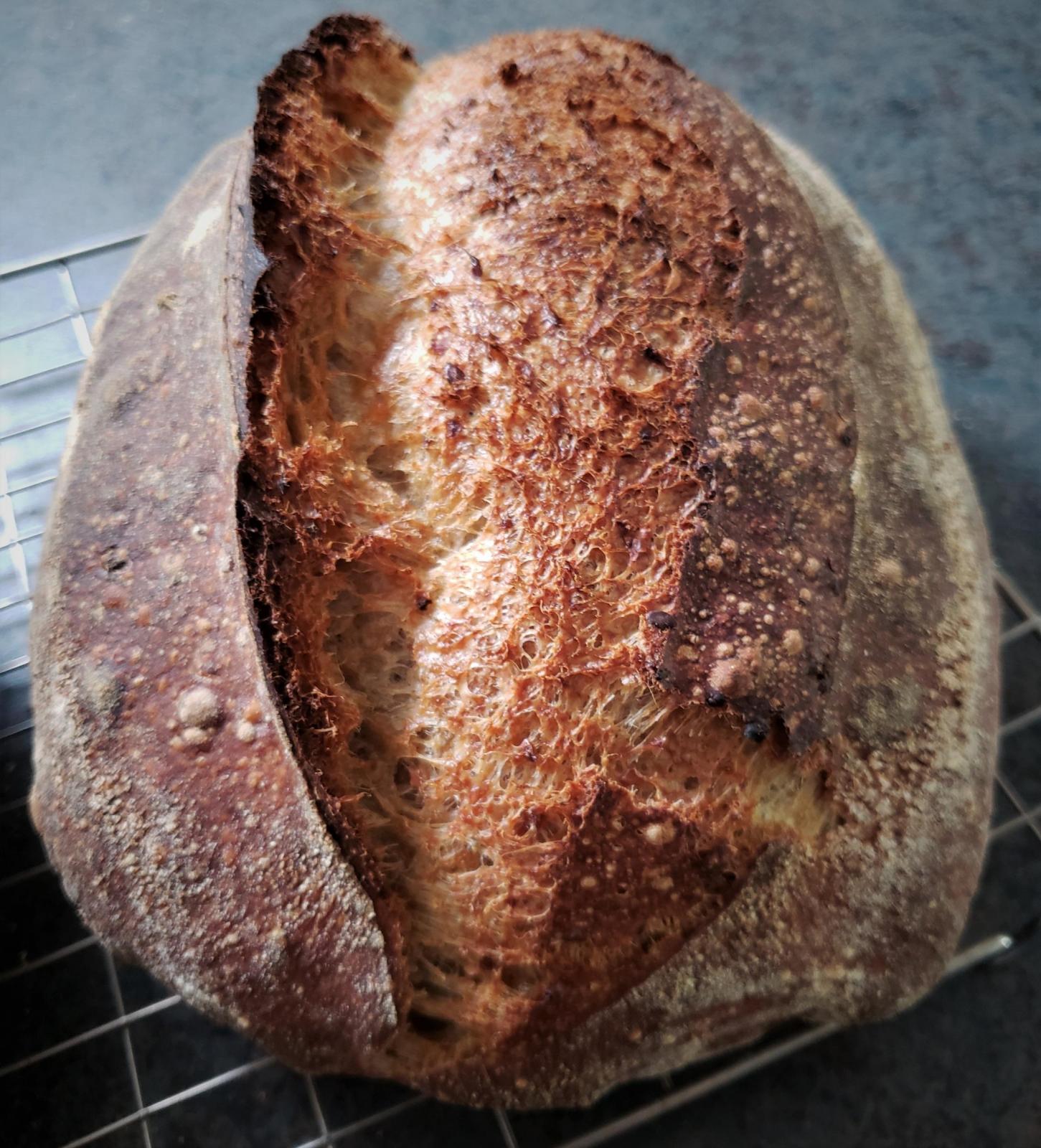
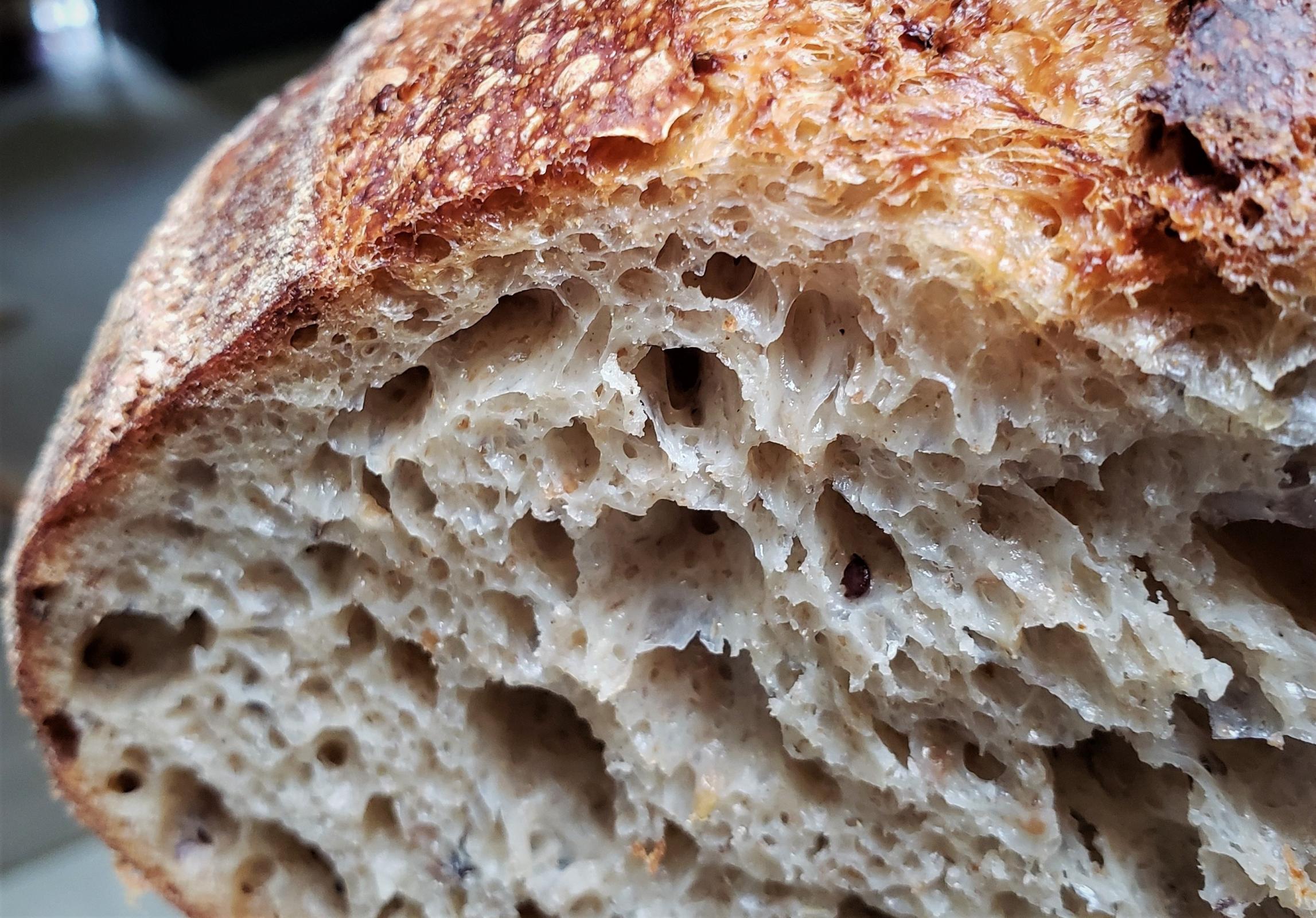
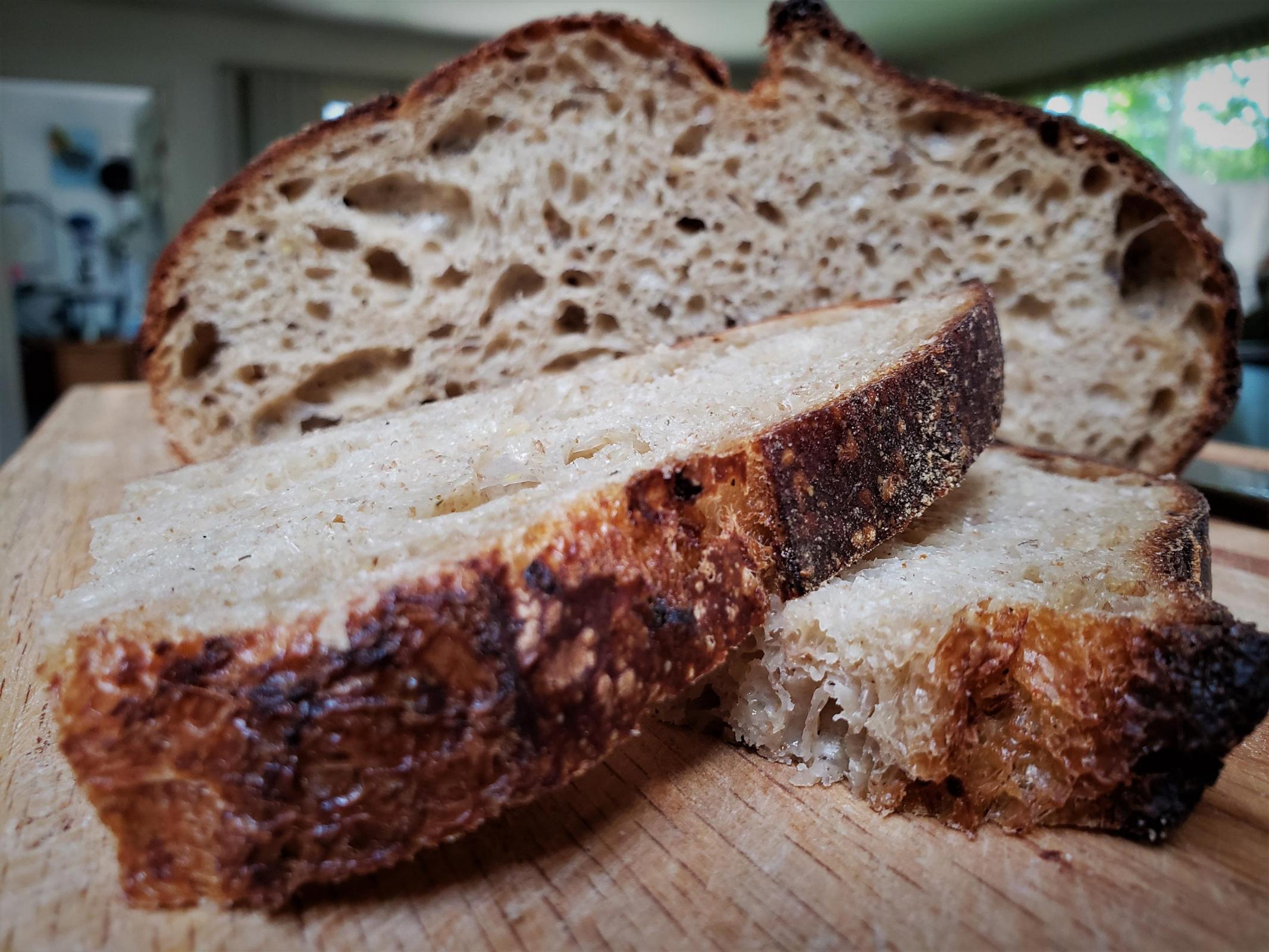
- Cedarmountain's Blog
- Log in or register to post comments
Awesome crust, crumb and bloom! I'd be very proud of myself to produce a loaf like yours. Basic ingredients are all it takes to make great bread.
The mixed grains porridge is very interesting. Must try it out soon.
Really fantastic bake indeed!
Hi Elsie, I have a tendency in the kitchen that "if a little is good, then lots is better"... that is something I am trying to change. As you say, basic ingredients are all it takes to make great bread, good quality ingredients will stand on their own if they're not overwhelmed by my tinkering! Thanks for your kind comments.
Nice bake! The crumb looks fantastic. I can actually imagine how nice the texture is. It looks like it has that classic porridge bread mouth feel. Yum!
Happy Baking :)
Ru
Hi Ru, so good to see you back on TFL...looking forward to seeing what you've got baking these days!
Your loaf looks great on the home page.
Congratulations :)
And that mix of grains has to taste wonderful, too.
Paul
Thank you Paul, the bread tastes really good, like I imagine bread should taste!
May I feature this one on the home page for a bit? It's a winner.
Thanks Floyd
You get the most amazing crumb! I love your breads!
Congrats on the front page!
As a side note, I have one of your old breads on the go. Thank you for the inspiration!
Hi Danni, thanks for your kind comments! What bread are you working on now?
your multigrain loaf where you used a porridge made with mashed Millet, Sprouted rye and ground flax. I have the rye sprouted and I am making the porridge tonight.
looking beautiful all around....yum! Kat
Thanks Kat!
some tie and I bet it tastes great too! Very nice indeed
Wow, thanks Dab...that's high praise from someone I regard as one of the TFL resident bread gurus!
Another masterpiece. Or have I said that before? It looks like Tartine breads, and I bet tastes as good. My oven would incinerate a loaf cooked that long. I'm currently down to 35 minutes.
Hi Phil, you're right about the oven...there are days my old oven burns bright and hot, other days when it is just plain unpredictable. As you have no doubt learned, never turn your back on the oven - it's always a wise decision to keep an eye on the loaves you've just invested hours to make! Thanks for your kind comments, looking forward to seeing your next bake!
You might be interested in an oven story. We have a Blue Star oven. A few years ago around the holidays I preheated the oven. Soon there was terrible smoke, and I suddenly realized I had stored leftover cinnamon buns on plastic trays in there when clearing up after an Xmas brunch we held. Luckily, while cleaning up this horrific mess, I found I was able to remove the bottom surface of the oven where a lot of the plastic has dripped. I scraped what I could with a metal dough scraper and used a kitchen torch on the rest, which worked.
What I found when I removed the bottom panel, though, was that many of the rivets attaching the spreader, which is attached to the underside of the panel, had melted over time, and the spreader now awkwardly slumped onto the heating element. I thought, perhaps this is why it takes so long for the oven to preheat. Within a month or two the oven was not turning on reliably. We had a repairman replace the starter, and reattach the spreader. The oven now started up right away, and the oven preheated quickly.
Only something had changed. My bread was now getting very dark on one side while the other side remained fairly raw. Before I simply rotated it halfway through the bake. Now I had to rotate after 10-15 minutes! I asked the repairman and was told that, even with the spreader, the heat is concentrated in the back. Ironically, fixing the spreader has made baking bread in this oven more difficult. It is also calibrated too low, so I'm now down from 460 F (Hamelman) to 450 F, and I'm going to keep going down 10 degrees until I'm back to 40 minute bakes.
As if the process of preparing the dough for baking isn't challenging enough! Makes me appreciate the efforts of the many people over the thousands of year that have baked bread under even more difficult circumstances. I watched a YouTube video several years ago about a South East Asian woman's daily bread baking routine. She was awake every morning at 4 am to get her wood oven fired up with twigs and wood she was constantly collecting; meanwhile she prepared her bread dough in a big metal wash tub, enough to feed her and her extended family, She set the dough balls out to proof on a piece of scrap metal, a piece of hood from a small car; she carefully carried the dough out on that to the oven and set another piece of the same scrap metal into the oven to pre-heat after scraping the coals into the back of the oven. She spent the next few hours baking the bread, turning the loaves, moving them around in the oven with a stick. The baking was all done by 10 am. Beautiful bread too, all set out to cool on the scrap metal and then piled into wicker baskets to deliver to various family members. It made me so grateful for my oven, cantankerous and unpredictable as it is!
Great story. Another one. A guy in my small town has a subscription baking operation. He had a brick oven built in his back yard. It's heated by natural gas, and takes about 24 hours to heat. I did a larger batch in his shop (garage), and he helped me scale it. Before loading he noticed that the heat was way up. He then sprayed it with a hose. About 20 minutes into the bake I commented that there seemed to be quite a bit of smoke coming out the exhaust pipe. He brushed it off. About 5 minutes later I got nervous and opened up the oven and found that most of the loaves (including some of his) were burnt. Mine had sprung beautifully, and I had jinxed the bake by telling several people in advance I was bringing them a loaf.
It's elementary that a higher heat would result in a quicker bake. But old habits are hard to break, and even an experienced baker can be lured by habit into a miscalculation. We salvaged a few of them, and they were fantastic. I was so proud of this bread. Hamelman multigrain levain, freshly milled grain, hand mixed, cold final rise, a triple size batch, 12 1.5 lb. loaves, in a different setting. It hurt a lot. As you say, this is a lot of effort to go to to not succeed. But failure is a great teacher.
Awww, what a hard lesson! Those were well on their way to becoming some beautiful loaves.
That's really "dark" baked bread...
Yes, as you can see, I like a bold bake (sob).
That is a beauty inside and outside! I love the 'shininess' of the crumb and put that on my 'baking list'.... oh and the ear.....stunning...
How did you cook 'the porridge' and you say you included it in after 4 S & Fs? Would that be towards the end of bulk? Kat
Hi Kat,
I cooked the mix of cracked grains for about twenty minutes with enough water to develop a loose consistency similar to a good oatmeal porridge. I should have noted in my post that I also sifted the cracked grains to remove the powdery, loose floury part before cooking; I didn't want it too gummy and pasty. And my preference is to add the porridge between the second and third stretch/folds, about an hour into the bulk fermentation. I have tried mixing various additions in at the beginning of the bulk ferment and at various times during the bulk fermentation and even during the final shaping; it seems to me that it all depends on the type of addition and how you sense the dough is developing. Trevor is very careful and gentle with his bread dough, handling it with care and attention to preserve the fermentation gas bubbles and developing gluten. With a fairly loose porridge like this it is not too difficult to gently mix it into the dough after the second series of stretch/folds while keeping in mind the developing dough structure. I hope this answers your questions. Happy baking!
and I want to be a bit more adventurous and start adding 'things' and that 'porridge' looks so ?! Kat
the look of the baked loaf, and the crumb - gorgeous. so glad to see you posting again, your bread is just lovely. thank you.
happy baking Cedarmountain
Leslie
Hello Leslie, thanks for having a look at my post and for your kind comments!
Perfect porridge bread. Crumb is just what it should be. I just put my latest porridge bread in the fridge. Hope it comes out as nice as yours ?.
Regards,
Ian
Hi Ian,
Again with the porridge bread, I know...what can I say other than I really like it! There's just something about the crumb texture and flavour - I am trying to figure out a good basic porridge sourdough to use as a base for further tinkering with other additions like you do. Looking forward to seeing what comes out of your fridge and oven tomorrow, thanks for you comments!
Hey, you come waltzing back into our meager little lives and just like that, out of the blue, you get top billing!
The close-up crumb shot is one for the ages. What a wonderful crumb. An' da crust ain't nuttin' eitha. Wow, what a great bake!
Now, if only you can produce a few loaves like Filomatic has in his lament above...
alan
I am a terrible dancer Alan, waltzing especially, and I have produced my fair share of really "dark bold baked " loaves just like Filomatic's. Thanks for your kind comments and encouragement, much appreciated as always!
The crumb looks so soft and stretchy. You could be a millionaire if you sell this!
It is a good bread, maybe not a millionaire bread but pretty good....thanks for your kind comments Pal!
I'm not familiar with Marquis wheat. Is it a Canadian brand of bread flour?
Ari
Hi Ari,
The short answer is yes, Marquis wheat is a Canadian heritage wheat but not a brand of flour; Marquis is known for the high quality of its grain and flour. I have the good fortune to have a crop share with a local organic grain farmer in Agassiz, the ancestral home of Marquis wheat in Canada. Five years ago he managed to get hold of some Marquis wheat, 80 grain seeds I believe, and over the past few years has carefully cultivated this wheat until he was able last Fall to harvest enough wheat to share with us. If you would like to know more about Canadian wheat, this link will take you to the Government of Canada agriculture site: http://www.agr.gc.ca/eng/news/scientific-achievements-in-agriculture/from-a-single-seed-tracing-the-marquis-wheat-success-story-in-canada-to-it…; This is a brief summary taken from the website:
"Marquis a Canadian heritage wheat with a history going back to the late 1800s early 1900s. It has its origins in the Red Fife wheat grown in Canada - briefly, Red Fife was originally grown in mid-Europe and it is thought that one of its kernels was conveyed in a cargo of winter wheat, via the Baltic and the North Sea, from Danzig to Glasgow; that a sample cargo containing that kernel was procured by someone at the Scottish port; that this sample was sent to David Fife at his farm in Ontario about the year 1842; that this single kernel germinated and produced a plant with three heads; that the kernels of these three heads, when sown the next year, gave rise to the wheat which became known as Red Fife. In 1904, a Canadian researcher named Charles Saunders discovered a new variety called Marquis. It was a cross between the early-ripening Indian wheat Hard Red Calcutta and Red Fife made by his brother A.P. Saunders in 1892 at the Experimental Farm in Agassiz, British Columbia. The individual ancestors of the Marquis variety were produced between 1904 and 1906. "
I just found this thread and your beautiful loaf and was inspired to shake up my tried and true recipe and try something new! I'm halfway through bulk ferment and going well. A question on the bran. You mentioned you use it to coat the loaf? How and when in the process? It is either that or some bran muffins tomorrow morning!
Duane
And figured I would answer since I don’t know if Cedar Mountain will see it on time.
Just sprinkle the bran in your baskets/bannetons prior to putting your loaves in there. It will stick nicely to your loaves when you turn them out to bake in the morning.
Thank you Danni and also Floydm for such a quick and thoughtful response! What a wonderful community you all have here of supportive and talented bread makers!